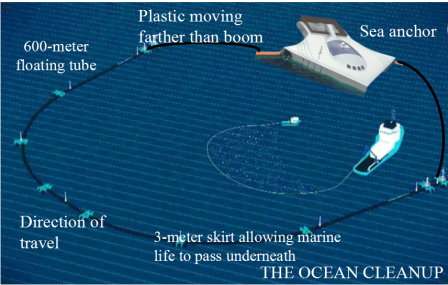1 . "When I was 16 years old, I was diving in Greece, but I was disappointed because I saw more plastic bags than fish.” These are the words of Boyan Slat, an engineer who designed the world's first ocean plastic cleanup system.

Every year, more than 8 million tons of plastics end up in our oceans, according to the UN Environment Programme. It is predicted that the weight of ocean plastics will match the weight of all the fish in our oceans by 2050. To prevent this from happening, in 2013 Slat created the Ocean Cleanup, an environmental non¬governmental organization, and put his plan for an ocean cleanup device into action.
After years of research and develop¬ment in the Netherlands, a device called System 001/B successfully started gathering plastics on October 2, 2019. The device uses a 600-meter-long C-shaped tube to gather all the floating rubbish. Unlike other cleanup methods, the system floats freely according to the direction of the waves, which allows waste to flow into and stay within the device. A sea anchor is attached to either end. This slows down the system as it floats through the water and allows the faster-moving rubbish, carried by the waves, to flow into its mouth. System 001/B can also collect waste below the surface using a 3-meter-deep skirt(挡板)attached to the end. After being gathered, the trash will be dragged back to shore by boat and recycled.
Right now, the system operates in the Great Pacific Garbage Patch, an area that is 3 times the size of France. Once operational, the Ocean Cleanup expects a full fleet to be able to clear 50% of the Great Pacific Garbage Patch in 5 years.
"It remains to be seen whether this dream will become a reality, but it is undeniable that humanity must work together to reduce our plastic use and repair the damage our waste has caused," Slat said. "We are starting to see a young generation that gets it and is excited about a sustainable (可持续的)future, but the question still comes down to: Are we going fast enough, and how much damage will have been done before we get there?"
1. The underlined word “match” in Paragraph 2 probably means “_________”.| A.compare | B.equal |
| C.measure | D.cover |
| A.To collect ocean plastic waste. |
| B.To help to invent System 001/B. |
| C.To protect the living environment of fish. |
| D.To do research on the ocean environment. |
| A.It can collect and recycle garbage at the same time. |
| B.It can only gather ocean waste which floats on the water. |
| C.It aims to clear up the Great Pacific Garbage Patch in five years. |
| D.It is an ocean-cleaning device which has already been put to use. |
| A.Young generations care less about the environment. |
| B.The future ecology of the oceans is deeply worrying. |
| C.People should work hard to decrease plastic pollution. |
| D.It's quite difficult to repair the damage to the environment. |
2 . Laura Sides was a psychology major at the University of Nottingham in 2004. She first noticed signs of her dad’s developing dementia(痴呆) when she moved to Nottingham. She said, "Dad was a doctor, so he knew exactly what had happened to him, but people try to hide it when they are ill. Then, I came home for my 21st birthday and arranged to meet him, but he never showed up as he’d forgotten. That’s when I knew something serious had happened."
So, aged 21, she decided to leave university and look after him herself. She lived close by, popping in every day to make sure he was eating, and that the house was tidy, before heading off to her work.
Besides challenging moments, there was a time when looking after her dad was a pure joy. "We’d wake up, I’d ask what he wanted to do that day, and however ridiculous the adventure is, off we’d go."
Sadly, in 2009, 5 years later, Laura lost her father. Before he died, Laura went to a hospital appointment with him, where doctors mentioned that his form of Alzheimer’s disease was genetic meaning there was a fifty-fifty chance that she had inherited it. For several years Laura agonised over whether to be tested, finally finding out in August 2017 that she has the APP gene, meaning that, like him, she will develop the condition within a decade.
At first, she struggled, feeling as if her life lacked purpose. Then, during a sleepless night in the summer of 2018, she decided at around 2 a.m. to enter the 2019 London Marathon sponsored by the charities Alzheimer’s Society and Alzheimer’s Research UK.
She hoped to start the conversation around early-onset Alzheimer’s disease and to encourage people to talk about it more openly. "I remember when Dad was ill, people wouldn’t know how to react, but I want to be honest and open," she added. "The more information we can get, the less of a taboo(忌讳) we will feel. That said, the support I’ve received so far after going public has been amazing — that’s what is carrying me through."
1. Laura noticed her father’s dementia when .| A.her father told her his condition in person |
| B.people nearby informed her of his father’s condition |
| C.her father forgot his own birthday party |
| D.her father forgot to attend her 21-year-old birthday party |
| A.excited | B.struggled |
| C.shocked | D.delighted |
| A.getting people to talk about Alzheimer’s disease openly |
| B.earning some money to help treat her Alzheimer’s disease |
| C.making herself stronger to fight against Alzheimer’s disease |
| D.raising funds for charities Alzheimer’s Society and Alzheimer’s disease Research UK |
| A.Caring and positive. | B.Careful and honest. |
| C.Patient and cautious. | D.Devoted and modest. |



